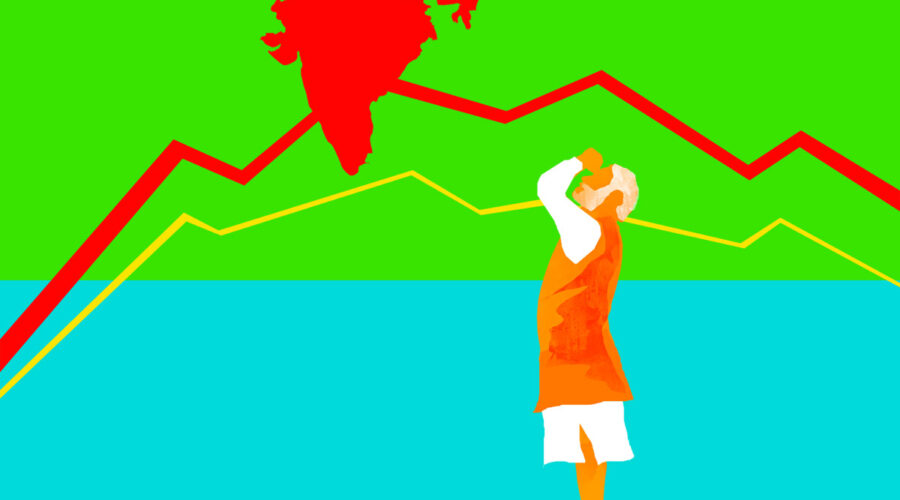Let’s Hope India Gets Lucky With Growth
After bumbling for years since 2014, the Modi government seems to believe that massive government expenditure will lead us to prosperity supported by ‘seat-of-the-pants’ decision-making, observes Debashis Basu.
The global gloom-and-doom scenario of 2022 (inflation, higher interest rates, and economic slowdown) continued into 2023, but the climate changed in the March quarter.
In the US, the inflation rate is down from 9.1 per cent in June last year to 6 per cent now.
In the eurozone, the rate has decreased from 10.6 per cent to 6.9 per cent, with Spain recording as low as 3 per cent.
With the benefit of hindsight, against each wave of the 2022 crisis, the Indian market has held up well.
If anyone asked you to guess the Nifty return in the 2022 calendar year, you would probably say down 10 per cent.
After all, last year seemed terrible for stocks.
In fact, the Nifty was up 4.33 per cent in 2022.
As the inflation rate declines, India has paused its interest rate hikes and there is optimism in the air that we have crossed the cyclical hump of a slowdown and should enjoy strong growth.
State-led growth
To believe in strong, secular growth, we first need to understand and believe in our growth model.
I am not at all clear as to what India’s growth model is because the government does not reveal much about its thinking; it only belts out non-stop propaganda about its claimed achievements.
We can deduce the growth model as tax-and-spend.
After bumbling for years since 2014, the Modi government seems to believe that massive government expenditure will lead us to prosperity supported by ‘seat-of-the-pants’ decision-making.
Hence, the sharp focus on defence, railways, and infrastructure, which are all big-bang spending opportunities directly overseen by the Central government.
Budget 2023-2024 announced a stunning capital outlay of Rs 10 trillion, of which allocation for the railway ministry is Rs 2.40 trillion, a whopping 75 per cent jump over FY23.
The Defence Production and Export Promotion Policy 2020 (DPEPP) has set an ambitious revenue target of Rs 1.75 trillion ($25 billion) by FY25, implying a 15 per cent CAGR (compound annual growth rate) between 2019 and 2025.
Procurement from domestic industry would double to Rs 1.40 trillion by FY25.
It is not clear whether this growth model (fuelled by government expenditure) has been fully thought through, or it is the default model, an unplanned outcome of continuing to keep the private sector shackled.
The entire growth of the 2014-2022 period has come from government borrowing and spending.
Indian households and businesses have contributed a negligible amount to it.
If this seems surprising, it is because we tend to forget even recent facts.
Remember the rising crescendo of criticism about how the government, far from reducing red tape, was turning the screws on the private sector? T V Mohandas Pai, an aggressive champion of every move of this government, had come out all guns blazing a few years ago.
‘Tax terrorism has gone rampant. The compliance burden has gone up massively. There is a fear psychosis. There is a feeling among government officials that all businessmen are crooks and we must go after them. I have never seen the mood and morale so down in Mumbai. Businessmen have given up hope.’
The late Rahul Bajaj had said: ‘There is no demand and no private investment. So where will growth come from? It doesn’t fall from the heavens.’
A M Naik of Larsen & Toubro had said, ‘We should feel lucky even if GDP growth comes at 6.5 per cent’, adding that he did not believe in government data anyway (his actual words were ‘the situation is challenging on data credibility’) and so one has to use one’s own judgement to get a sense of actual growth.
By late 2019, every economic indicator was flashing red — rising unemployment, poor export growth, punitive taxes, tax terrorism, an imploding public sector, a collapse of the GDP growth rate to 5 per cent (3.5 per cent according to the old calculations) in the first quarter, auto sales at a 20-year low, no manufacturing growth, and a crisis in financial services and banking.
It was easy for Manmohan Singh, who was the constant butt of jokes for Narendra Modi, to get back at him by pointing out that nominal GDP growth was at a 15-year low, household consumption at a four-decade low, unemployment at a 45-year high, bad loans of banks at an all-time high, growth in electricity generation at a 15-year low, and so on.
The Modi government could have changed the economic climate if the State were to act as a referee to maintain peace, deliver quick justice, and minimise frictional costs while encouraging private institutions to act out their enterprise and vision in every area, at a lower cost of infrastructure — power, toll, fuel, and taxes.
Instead of these structural changes, in a desperate move in September 2019, the Modi government announced huge tax cuts for the corporate sector to kick-start growth.
The jury is out on whether this knee-jerk move has achieved much.
Perhaps not, since the government has been forced to take on the burden of creating growth through the tax-and-spend model.
There are obvious limitations to this model in a structurally weak economy, comprising a bloated state (propped up by high-interest costs and high government salaries), a weak rupee, and a private sector that is kept uncompetitive by red tape and a high cost of infrastructure.
Feeble institutions (legal and administrative) make it hard to increase state efficiency too, no matter what the intent.
The heavy hand of the State has rolled the dice of growth.
Let’s hope we get lucky with what the dice comes up with.
Debashis Basu is the editor of moneylife.in and a trustee of the Moneylife Foundation
Source: Read Full Article

